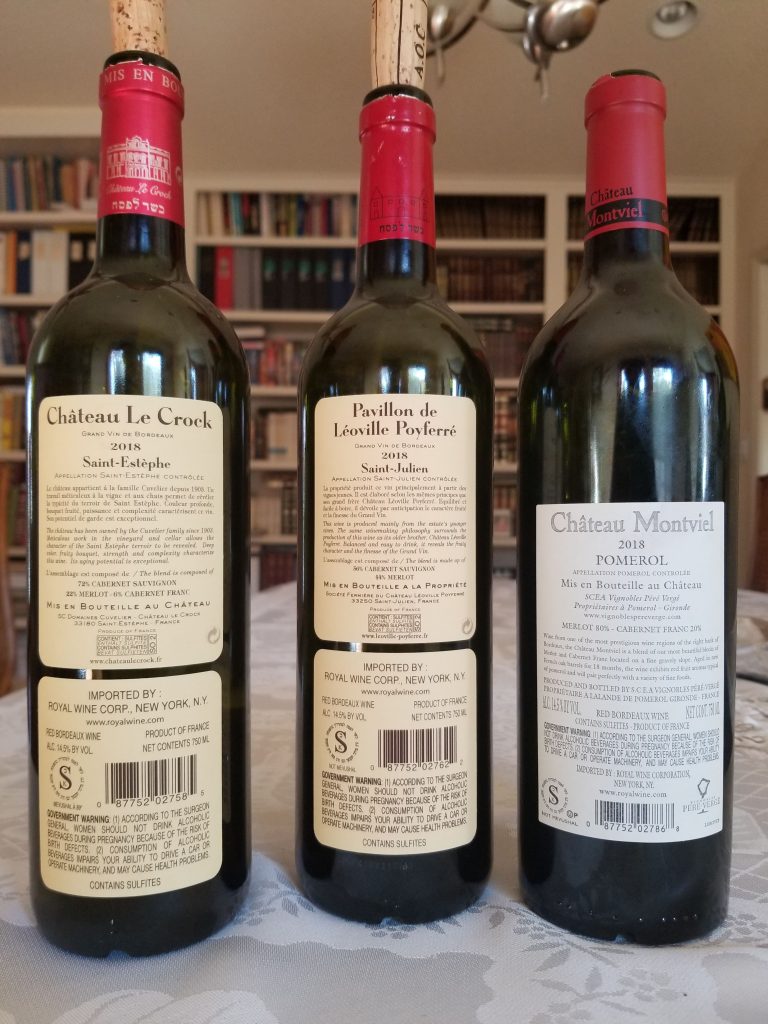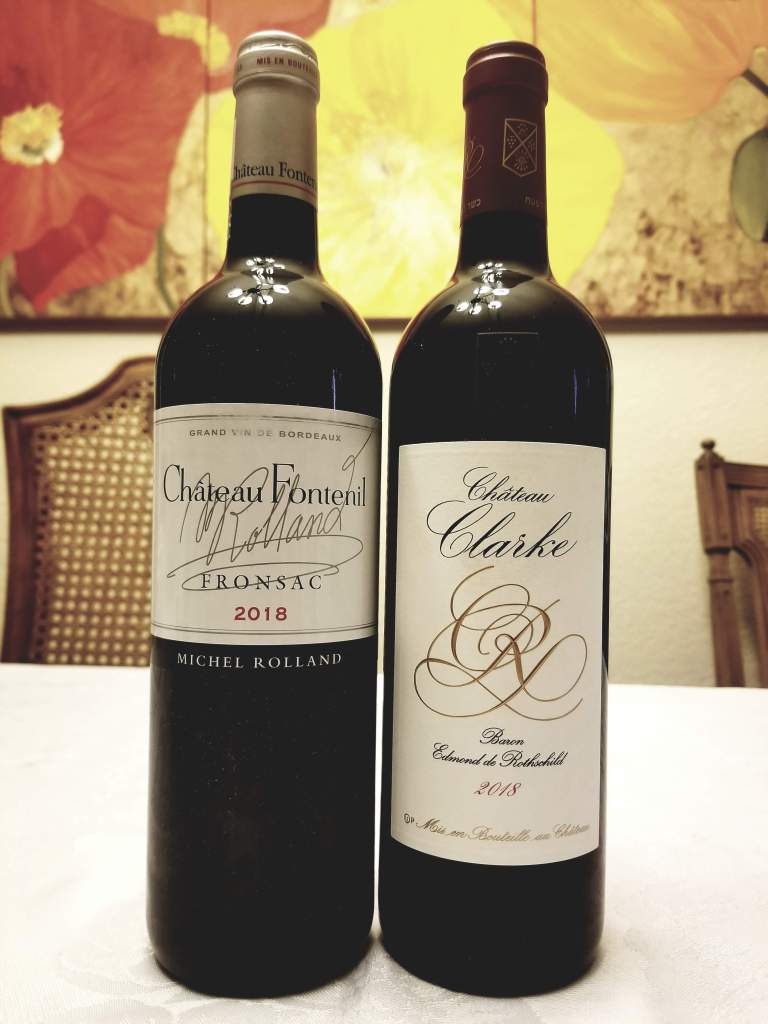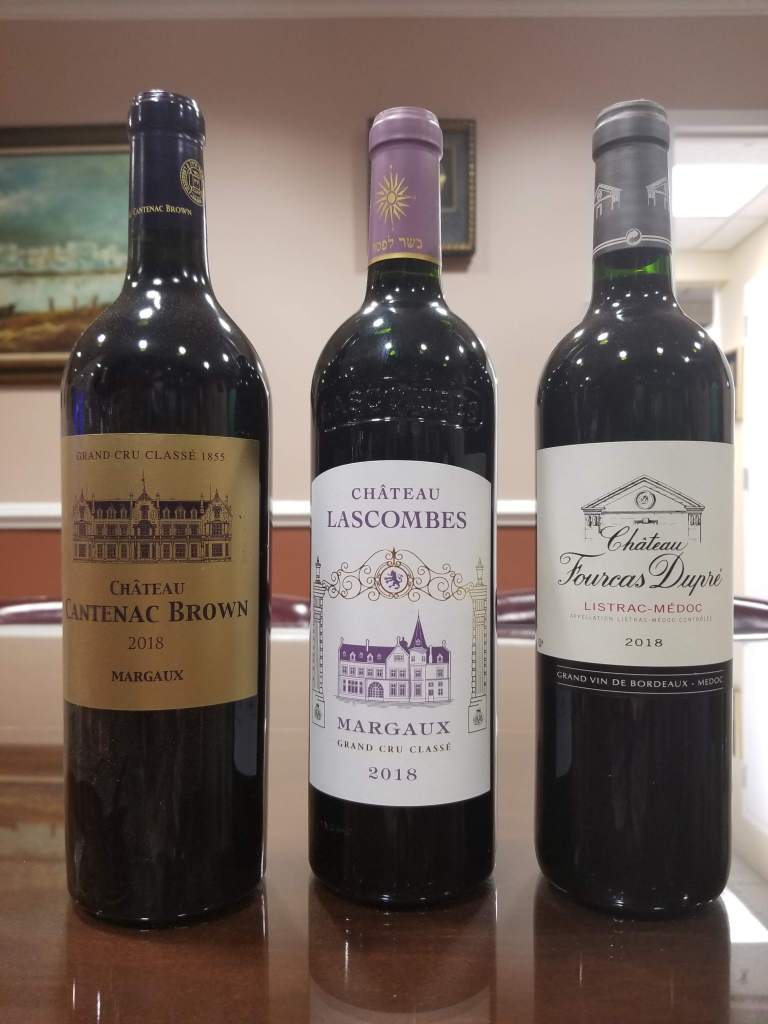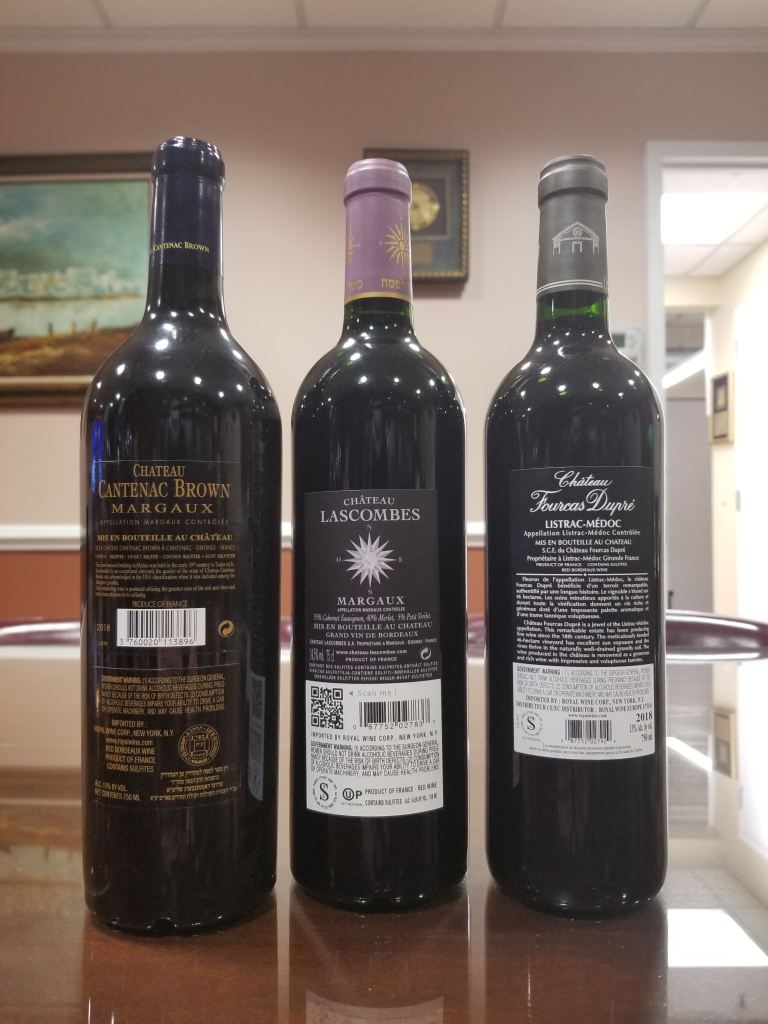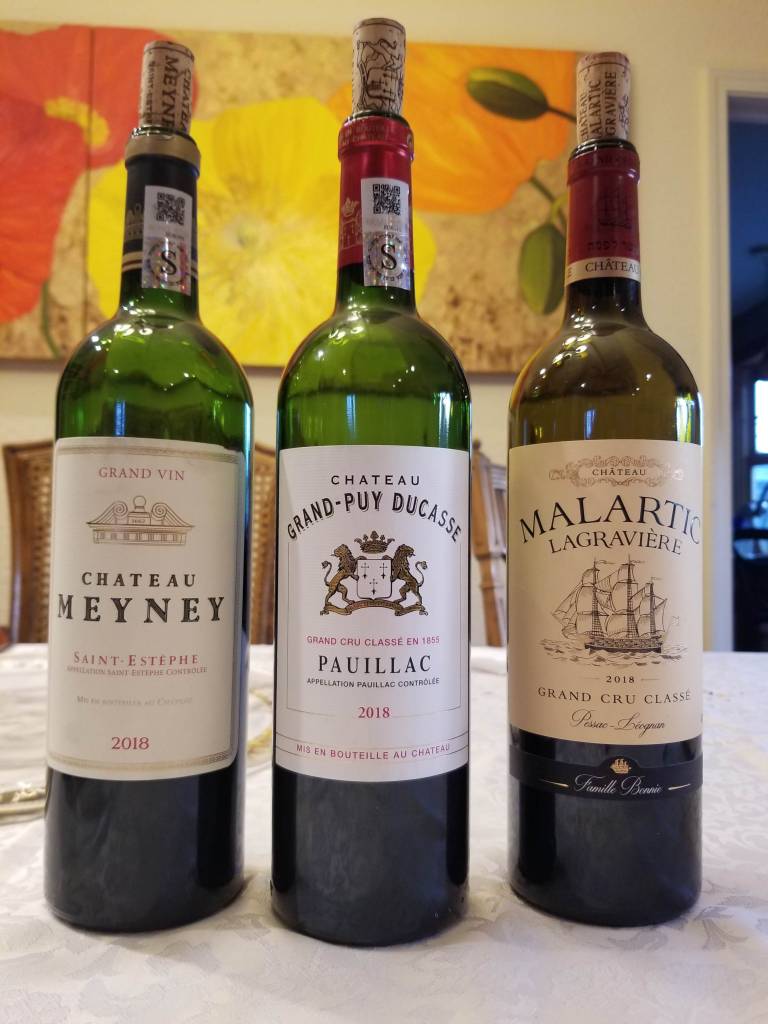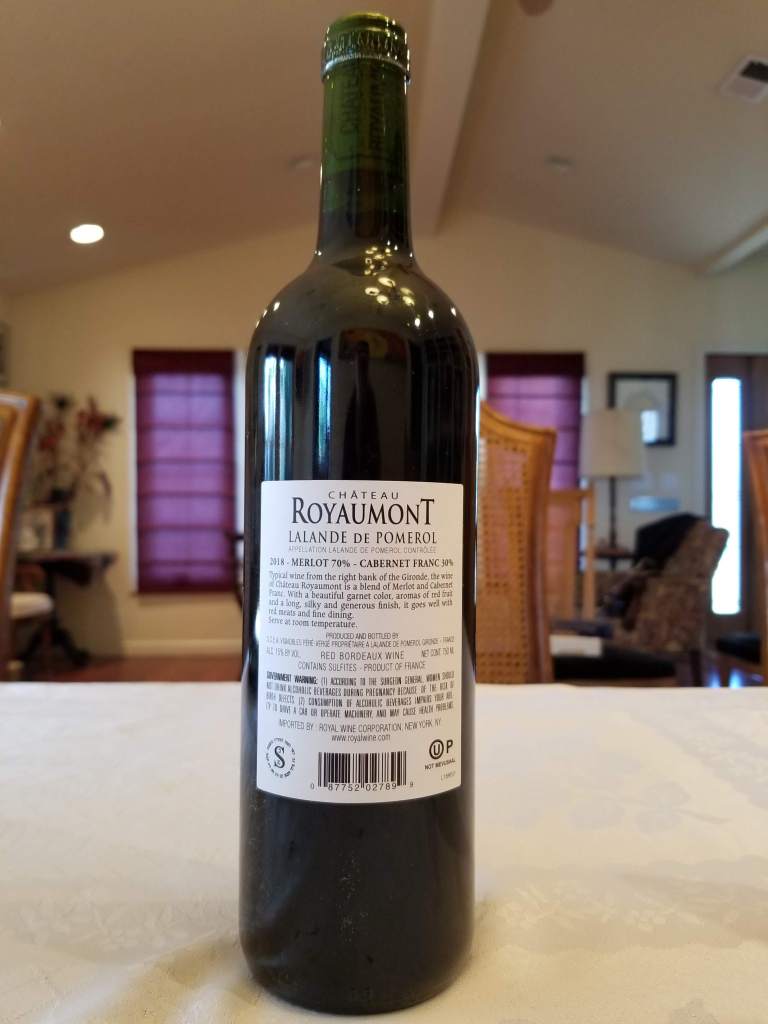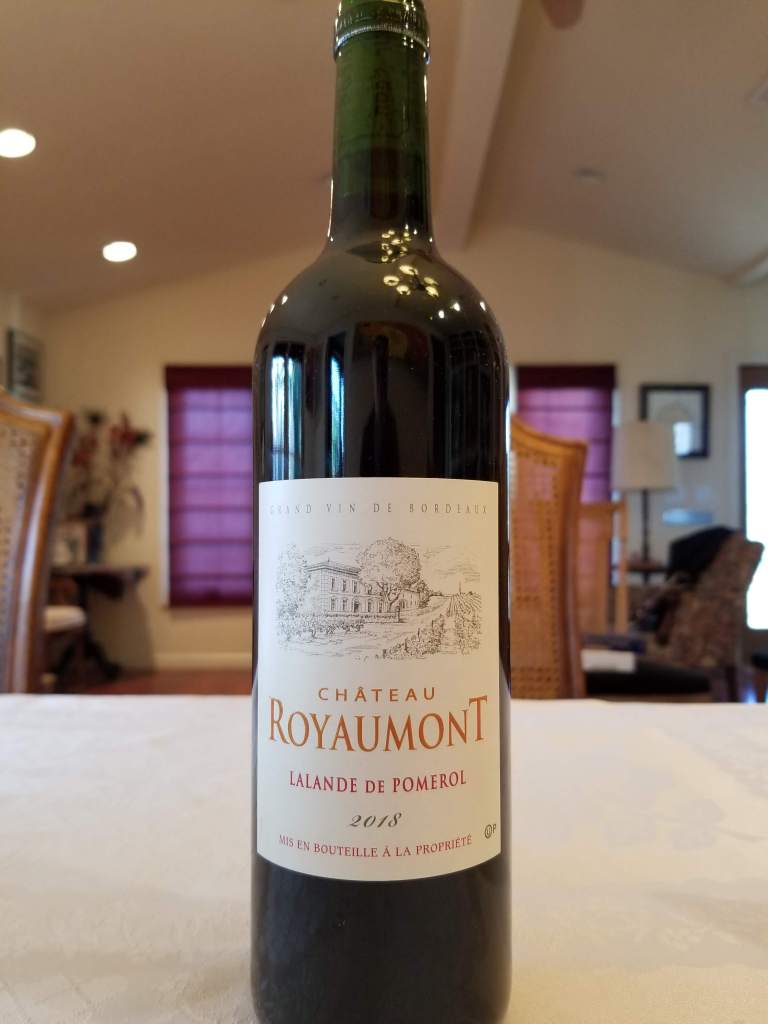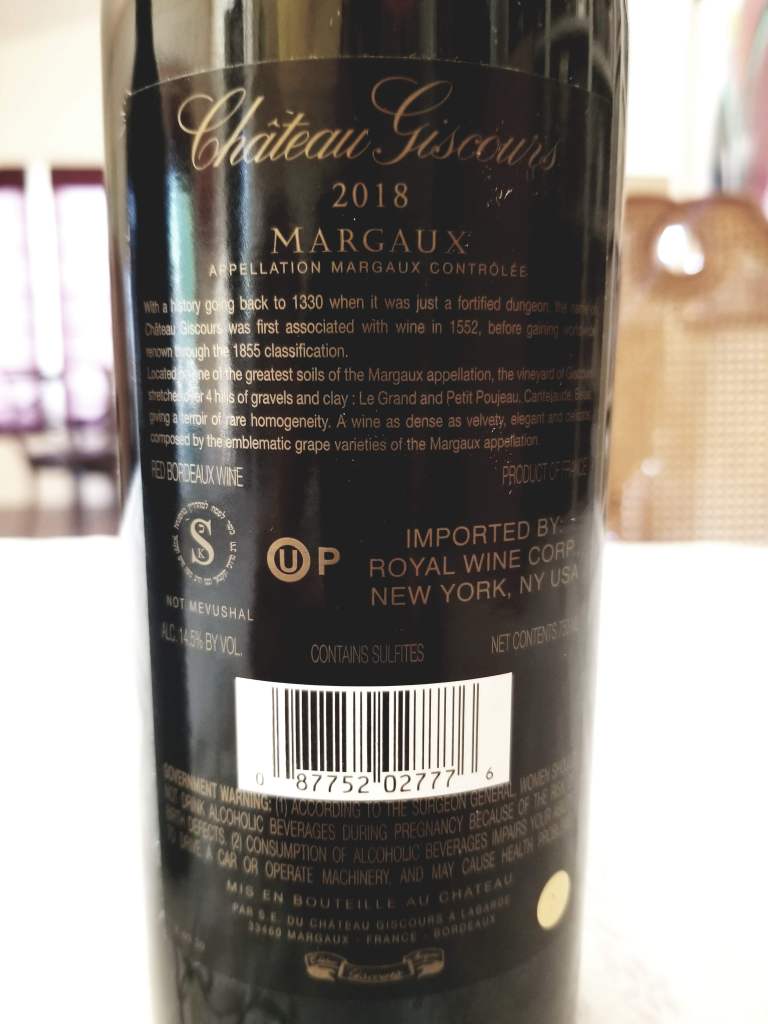Blog Archives
Finishing my tasting of Royal Wine’s 2018 French wines in California
Posted by winemusings
I know some of you are hoping for posts from my trip to France. However, I need to clean-up some missing posts, I have a lot of wine that needed to be posted and now I will do those quickly. After that I will start posting the wines I tasted in France.
So, back in November 2020, I did a tasting at my home to taste the 2018 wines from Royal, at least the ones that were here in the USA at that time. I will skip much of the text that I wrote then, but I will repost all the 2018 notes, to make it complete. Remember, all my notes have tasting dates on them.
In a previous post about the most recent French wines (at that time in 2017) that were arriving on the market – I already spoke about pricing and supply, so there is no need to talk that over again in this post.
While the 2015 and 2016 vintages were ripe, and the 2017 vintage was not ripe at all, the 2018 vintage makes the 2015 ripeness look tame! Now that is a very broad-stroke statement that cannot be used uniformly, but for the most part, go with it!
I see no reason to repeat what Decanter did – so please read this and I will repeat a few highlights below.
For a start, the drought came later in 2018,’ says Marchal, pointing out that early July saw less rain in 2016. ‘But when it came in 2018, it was more abrupt, with the green growth stopping across the whole region at pretty much the same time’. He sees it closer to 2009, but with more density to the fruit. … and high alcohols!
Alcohols will be highest on cooler soils that needed a long time to ripen, so the Côtes, the Satellites, and the cooler parts of St-Emilion have alcohols at 14.5-15%abv and more. I heard of one Cabernet Franc coming in at 16.5%abv, but that is an exception. In earlier-ripening areas, such as Pessac-Léognan and Pomerol, alcohols are likely to be more balanced at 13.5% or 14%abv, as they will have reached full phenolic ripeness earlier.
‘Pessac-Léognan did the best perhaps because it’s an early ripening site,’ said Marie-Laurence Porte of Enosens, ‘so they were able to get grapes in before over-concentration. If you had to wait for phenolic ripeness, that is where things could get difficult’.
The final averages per grape, according to Fabien Faget of Enosens, are Sauvignon Blanc 13.5%abv, Sémillon 12.5%abv, Merlot 14.5%abv, and Cabernet Sauvignon 14%abv’.
Final comments, disclaimer, and warnings
These wines are widely available in the USA, so support your local wine stores folks – they need your help! If you live in a wine-drinking desert, like California, support the online/shipping folks on the side of this blog. They are folks I buy from (as always – I NEVER get a bonus/kickback for your purchases)!
Again, I am just posting the 2018 reds and a couple of other wines that have changed in a good and bad way. My many thanks to Royal Wine for their help in procuring some of these wines. The wine notes follow below – the explanation of my “scores” can be found here:
2018 Les Marronniers Chablis (M) – Score: 88 (QPR: EVEN)
Sadly, as I continue to watch this wine evolve I feel it is not a wine that I will stock up on. This and the 1er Cru, sadly. The reason is that the wine keeps losing acidity as it ages. We opened the wine on Friday afternoon, and even then it had turned, and by Shabbat morning the acidity was far removed from where it was on Friday and that feels further removed from my notes and memories.
This wine is made with native yeasts and as little manipulation as possible. The nose on this wine is beautiful with orange blossom, yellow apple, and rosehip, with lemon curd, and yeasty and creamy notes. The mouth was lovely in the past, at this point, it has moved even further. The mouth on this medium-bodied wine is not as acidic as in the past and it is time to drink, sweet Meyer lemon, quince, pie crust, with Anjou pear, and nice peach. The finish is a bit short, with baked pear and apple, cinnamon, nutmeg, some mineral, and now the fruit is showing sweeter. Drink now. (tasted March 2021)
2018 Les Marronniers Chablis, Premier Cru, Cote de Jouan – Score: 88 (QPR: POOR)
Sadly, as I continue to watch this wine evolve I feel it is not a wine that I will stock up on. This and the 1er Cru, sadly. The reason is that the wine keeps losing acidity as it ages. We opened the wine on Friday afternoon, and even then it had turned, and by Shabbat morning the acidity was far removed from where it was on Friday and that feels further removed from my notes and memories.
The nose on this wine still shows floral notes, starting with rosehip and yellow flowers, followed by some minerals, slate, blossom water, apple, and smoke. The mouth on this medium-bodied wine is where things have gone wrong, with a bit of weight at this time, yellow apple, some citrus, Asian Pear, nice peach/apricot, Orange pith, hints of nectarines and orange. Sadly, as I state above the acidity slows early and leaves in a few hours, so while I loved the wine at release, it is not for long holding. Drink now. (tasted March 2021)
Red Wines ordered by Vintage and QPR
2018 Chateau Le Crock, Saint-Estephe (M) – Score: 93 (QPR: WINNER)
The nose on this wine, is deep dark beautiful notes of black and red fruit, with rich salinity, mineral galore, with lovely tar, smoke, and what I crave from French wine – DIRT, DIRT, and more dirt! The nose is lovely, with green notes lurking in the background, and lovely licorice.
So, while I have been unhappy with the 2018 vintage so far, this wine returns my hope for the vintage, this wine is better than 2016, and that IS SAYING a lot!
This wine is a blend of 72% Cabernet Sauvignon, 22% Merlot, and 6% Cabernet Franc. The 2018 vintage has more Cab in it and it smells blacker than 2016 in many more ways than just that. Lovely wine! The blueberry of the past is gone and all you get is this intense earth, dirt, smoke, along with some shockingly beautiful violet, black and red fruit bonanza, with ripples of minerality through it – bravo and this is the Mevushal version!
The mouth on this full-bodied beast is impressive, with rich extraction, like in 2016, deeply concentrated, yet with lovely finesse and elegance, showing a richness that belies its youth, with blackberry, dark, yet controlled, plum, dark raspberry, earth, cherry, smoke, and a mouth draping elegance in the tannin structure that is impressive for its youth, with a lovely plushness, with deep furrows of graphite, saline, and rock. The finish is long, not so green, there is a few green notes, more in the way of tobacco than in the way of foliage, but here the finish is about the dirt, loam, forest floor, smoke, and dark chocolate, with hints of oak, with crazy acidity, leather, all wrapped in roasted herbs that linger long and forever. Bravo!!! This is the best Chateau Le Crock, I have ever tasted, at least in regards to the Mevushal version! Drink from 2025 until 2037. Incredible! (tasted Nov 2020)
2018 Chateau Royaumont, Grand Vin Bordeaux – Score: 93 (QPR: WINNER)
This wine is a blend of 70% Merlot & 30% Cabernet Franc. The nose on this wine is balanced, though a bit ripe, with bright fruit, ripe plum, dark cherry, anise, menthol, tobacco, with green notes from the Cabernet Franc, foliage, smoke, and slightly burnt oak. The mouth on this full-bodied wine is well-balanced, with loads of fruit to start, layered, concentrated, plush, with screaming acid, black raspberry, plum, smoke, oak, rich fruit, nice saline, good dirt, earth, black pepper, with ripe fruit, and loads of mouth draping tannin. The finish is long, ripe, with loads of sweet chewing tobacco, dark chocolate almost milky, with more earth, graphite, and smoke galore. Nice! Drink from 2028 until 2034. (tasted May 2021)
2018 Chateau Fourcas Dupre, Listrac-Medoc – Score: 92+ (QPR: WINNER)
This wine is a blend of 44% each Cabernet Sauvignon and Merlot, with 10% Cabernet Franc and 2% Petit Verdot. The nose on this wine is ripe, scary ripe, but under a blanket of dirt, earth, smoke, more ripe fruit, mushroom, forest floor, and earth, wow! The mouth on this medium-bodied wine is lovely, rich, layered, elegant, but ripe, but the ripeness is balanced well by the acidity, with incredible dirt, along with floral notes, blackberry, currant, plum, and rich salinity, with dark chocolate, smoke, and rich loam, acid galore, and smoke. The finish is long, green, black, and mineral-driven, with loads of scrapping graphite, dirt, and foliage, wow! Bravo!! Drink from 2026 until 2033. (tasted January 2021)
Share this:
- Click to email a link to a friend (Opens in new window) Email
- Click to share on Facebook (Opens in new window) Facebook
- Click to share on Pinterest (Opens in new window) Pinterest
- Click to share on LinkedIn (Opens in new window) LinkedIn
- Click to share on X (Opens in new window) X
- Click to share on Tumblr (Opens in new window) Tumblr
- Click to print (Opens in new window) Print
- Click to share on Reddit (Opens in new window) Reddit
Posted in Kosher Dessert Wine, Kosher French Wine, Kosher Red Wine, Kosher White Wine, Kosher Wine, Wine, Wine Tasting
Tags: 1er Cru, 2018 Chateau Fontenil, Baron Edmond de Rothschild, Chateau Cantenac Brown, Chateau Clarke, Chateau Du Tertre, Chateau Fourcas Dupre, Chateau Giscours, Chateau Guiraud, Chateau Le Crock, Chateau Malartic Lagraviere, Chateau Meyney, Chateau Montviel, Chateau Piada, Chateau Rayne Vigneau, Chateau Royaumont, Château Grand-Puy Ducasse, Château Lascombes, Fronsac, Les Marronniers Chablis, Listrac-Medoc, Pavillon de Leoville Poyferre, Petit Guiraud, Pomerol, Royal Wine, Saint-Estephe, Saint-Julien
Tasting of Royal Wine’s 2018 and some 2019 French wines in California
Posted by winemusings
Well, it is official, 2020 continues to take, and though my annoyances are minor in comparison to the pain others are feeling, it still has impacted my routine, which I guess is the story of 2020. For the past three years, I have been tasting Royal’s latest wines with the man in France for Royal, Menahem Israelievitch. Sadly, this year, no matter how much I planned and tried, it is a no go. So, for the first time, in a long time, the tasting will be here in Cali and it will only be a small part of the 2018 and 2019 wines, such is life.
So, no there will not be a picture with all the wines, and some of the wines from last year are still not here right now! But, I will post here what I did taste so far, and my overall feeling of the 2018 and 2019 vintages.
In a previous post about the most recent French wines (at that time in 2017) that were arriving on the market – I already spoke about pricing and supply, so there is no need to talk that over again in this post.
While the 2015 and 2016 vintages were ripe, and the 2017 vintage was not ripe at all, the 2018 vintage makes the 2015 ripeness look tame! Now that is a very broad-stroke statement that cannot be used uniformly, but for the most part, go with it!
I see no reason to repeat what Decanter did – so please read this and I will repeat a few highlights below.
For a start, the drought came later in 2018,’ says Marchal, pointing out that early July saw less rain in 2016. ‘But when it came in 2018, it was more abrupt, with the green growth stopping across the whole region at pretty much the same time’. He sees it closer to 2009, but with more density to the fruit. … and high alcohols!
Alcohols will be highest on cooler soils that needed a long time to ripen, so the Côtes, the Satellites, and the cooler parts of St-Emilion have alcohols at 14.5-15%abv and more. I heard of one Cabernet Franc coming in at 16.5%abv, but that is an exception. In earlier-ripening areas, such as Pessac-Léognan and Pomerol, alcohols are likely to be more balanced at 13.5% or 14%abv, as they will have reached full phenolic ripeness earlier.
‘Pessac-Léognan did the best perhaps because it’s an early ripening site,’ said Marie-Laurence Porte of Enosens, ‘so they were able to get grapes in before over-concentration. If you had to wait for phenolic ripeness, that is where things could get difficult’.
The final averages per grape, according to Fabien Faget of Enosens, are Sauvignon Blanc 13.5%abv, Sémillon 12.5%abv, Merlot 14.5%abv, and Cabernet Sauvignon 14%abv’.
The Mevushal push, from Royal wines, is continuing for the USA labels, a fact I wonder about more and more. Look, if you are going to force Mevushal wine down our throats, why not import BOTH? If you look at the numbers for wines like we will taste in the post, the majority of the buyers are not restaurants or caterers. Sorry! No matter how much Royal Wines wants to fool itself into thinking. Throw in COVID and FORGET about this INSANITY, please! I beg of you!
There is no denying that it affects the wine, it does. I have tasted the Chateau Le Crock side by side, the Mevushal, and non-Mevushal and while I feel that Royal does a good job with the boiling, it is still affected. If you want to have Mevushal wines in the USA, then bring them BOTH in! Royal does this for Capcanes Peraj Petita and the undrinkable Edom and others in Israel. So what Royal is saying is – that could not sell the Chateau Le Crock numbers that they import into the USA without boiling it? Why else would they feel forced to boil it and import it if not otherwise? To me, it makes me sad, and in a way, it disrespects what Royal is trying to do to its French wine portfolio, IMHO. They should, at minimum, import both! Allow for the caterers and restaurants (like anyone needs that nowadays – HUH???) to have the Mevushal version and sell the non-mevushal version to us, as you do with Edom and Petita. There I have stated my peace, I am 100% sure I will be ignored – but I have tried!
The Mevushal wines from France for the 2018/2019 vintage will be, the 2018 Barons Edmond et Benjamin de Rothschild, Haut-Medoc, 2018 Chateau Greysac, 2018 Chateau Chateau de Parsac, 2018 Les Lauriers, Des Domaines Edmond de Rothschild, 2018 Chateau Le Crock, 2019 Chateau Les Riganes, Red, 2018 Chateau Genlaire, along with the whites wines, the 2019 Bourgogne Les Truffieres, Chardonnay, the 2019 Les Marronniers, Chablis, and the 2019 Chateau Les Riganes, Blanc.
Now does mevushal impede the long-term viability of aging in regards to the wine? Well, that too is not something that we have scientific proof of. I have tasted a mevushal 1999 Herzog Special Edition and it was aging beautifully! So, would I buy the mevushal versions of the wines I tasted below – yes! Would I age them? Yes, I would hold them for slightly fewer years.
Other than the mevushal aspect, there are no differences between the European version of the wines and the USA version of the wines. While that sounds obvious, I am just stating it here. The wines will be shipped now and the temperature issues that affected Israel’s wines of old, have not been a factor here.
The “other” wines not here yet or I have not had
There is the just-released 2018 Château Cantenac Brown Margaux (will post that when I get it), along with these yet unreleased wines. The 2019 Chateau Gazin Blanc (2018 was/is INCREDIBLE), 2018 Chateau Fourcas Dupre, 2018 Château Meyney Saint Estèphe, 2018 Chateau Giscours, 2018 Chateau Lascombes, 2018 Chatyeau Tertre, and 2018 Chateau Royaumont.
I understand this is a sub-optimal situation and blog post. It does not cover Royal’s 2018/2019 European wine portfolio. Still, it covers what has been released (or very close to it), here in the USA, and hopefully, it will help you. One day soon, I hope and pray, things will return to some semblance of normalcy, and we will all travel around again. Until then, this is the best I can do. Stay safe!
Final comments, disclaimer, and warnings
First, there are a TON of QPR winners but there are also a LOT of good wines that I will be buying. Please NOTE vintages. The 20016 Haut Condissas is a disaster while the 2017 vintage is fantastic! So, please be careful!
These wines are widely available in the USA, so support your local wine stores folks – they need your help! If you live in a wine-drinking desert, like California, support the online/shipping folks on the side of this blog. They are folks I buy from (as always – I NEVER get a bonus/kickback for your purchases – NOT MY STYLE)!
Sadly, there was no plane trip, no hotels, no restaurants, nothing. So, no trip to talk about – just the wines and my lovely home! Stay safe all and here are the wines I have had so far. I have also posted many scores of 2015, 2016, 2017, and 2018 wines which are still for sale here in the USA. My many thanks to Royal Wine for their help in procuring some of these wines. The wine notes follow below – the explanation of my “scores” can be found here:



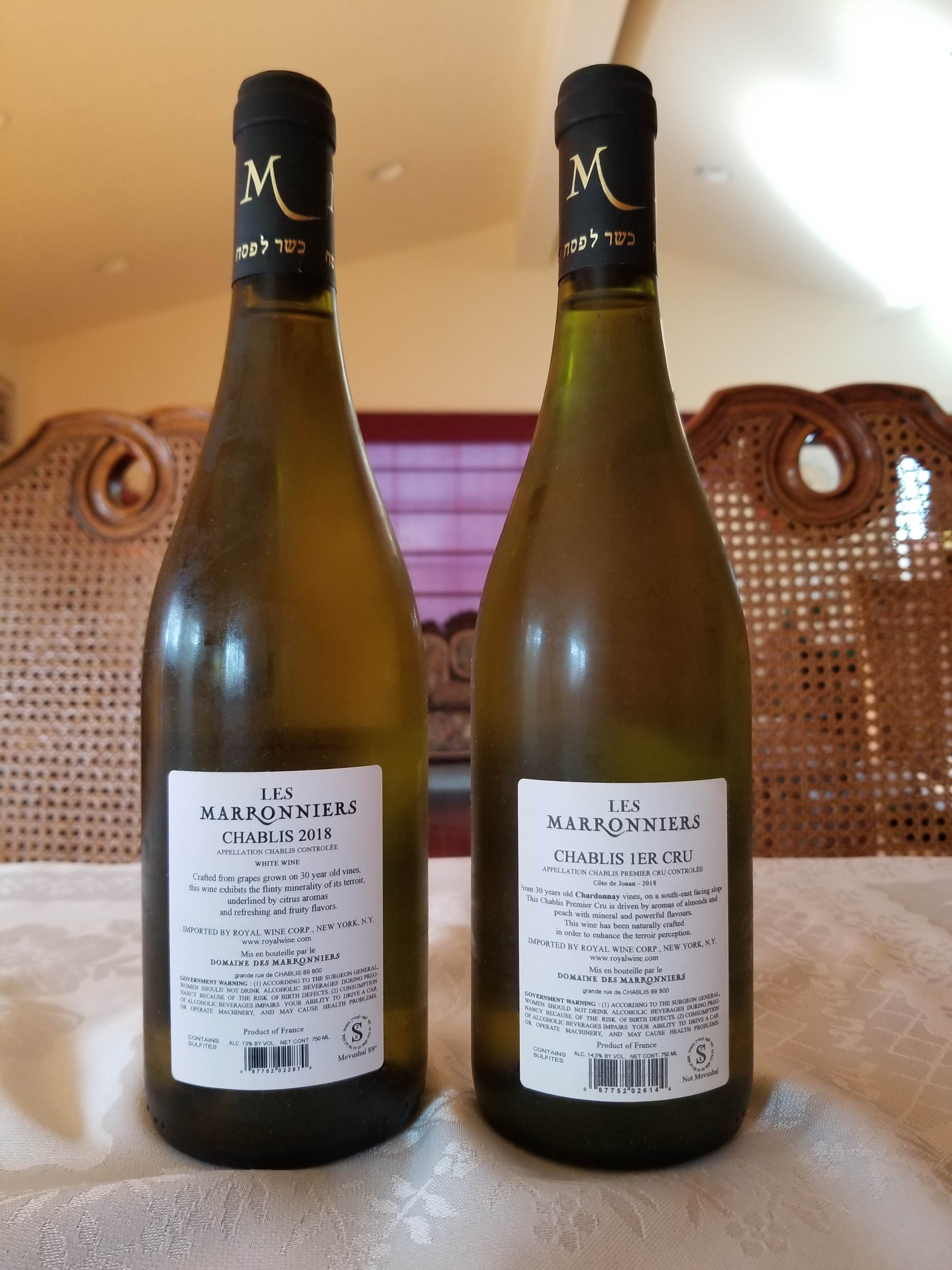






Share this:
- Click to email a link to a friend (Opens in new window) Email
- Click to share on Facebook (Opens in new window) Facebook
- Click to share on Pinterest (Opens in new window) Pinterest
- Click to share on LinkedIn (Opens in new window) LinkedIn
- Click to share on X (Opens in new window) X
- Click to share on Tumblr (Opens in new window) Tumblr
- Click to print (Opens in new window) Print
- Click to share on Reddit (Opens in new window) Reddit
Posted in Kosher French Wine, Kosher Red Wine, Kosher Semi Sweet Wine, Kosher White Wine, Kosher Wine, Wine, Wine Tasting
Tags: 2018 Chateau Fontenil, Baron Edmond de Rothschild, Barons de Rothschild Edmond Benjamin, Blanc, Blaye, Chablis, Chateau Clarke, Chateau D'Arveyres, Chateau de Parsac, Chateau de Santenay, Chateau Du Tertre, Chateau Fourcas Dupre, Chateau Gazin Rocquencourt, Chateau Genlaire, Chateau Giscours, Chateau Greysac, Chateau Guiraud, Chateau Haut Condissas, Chateau La Clare, Chateau La Petit Chaban, Chateau La Tonnelle, Chateau Lamothe-Cissac, Chateau Le Crock, Chateau Leoville Poyferre, Chateau Les Riganes, Chateau Malartic Lagraviere, Chateau Mayne Guyon, Chateau Montviel, Chateau Moulin Riche, Chateau Piada, Chateau Rollan de By, Chateau Royaumont, Chateau Saint-Corbian, Chateau Signac, Chateau Tour Seran, Château Lascombes, Chevalier de Lascombes, Cote de Jouan, Coteaux du Giennois, Cotes Du Rhone, Domaine de Panquelaine, Domaine Ternynck Bourgogne, Fronsac, Grand Cru, Grand Cru Classe, Haut-Medoc, Jean-Pierre Bailly, Lalande de Pomerol, Le Classique, Les Bois de Lalier, Les Lauriers, Les Marronniers Chablis, Les Roches, Les Truffieres, Limited Edition, Listrac-Medoc, Margaux, Medoc, Mercurey, mevushal, Montagne-St-Emilion, Old Vines, Pascal Bouchard, Pavillon de Leoville Poyferre, Pessac-Leognan, Petit Guiraud, Pliocene, Pomerol, Pouilly-Fume, Premier Cru, Premier Grand Cru Classe, Prestige, QPR, Ramon Cardova, Rioja, Saint-Emilion, Saint-Estephe, Saint-Julien, Sancerre, Sauternes, Sauvignon Blanc, Sec
My top 25 kosher wines of 2018 including wine of the year and best wine of the year awards
Posted by winemusings
Like last year, I wanted to make this post short and sweet – so the criteria are simple I could care less about price, color, or where it was made. All that matters is that it is/was available this year sometime to the public at large and that I tasted it in a reliable environment, not just at a tasting, and that it was scored a 93 or higher. Also, there are a few lower scoring wines here because of their uniqueness or really good QPR. I also included some of the best wines I tasted this year – they are at the bottom.
We are returning with the “wine of the year”, and “best wine of the year”. Wine of the year will go to a wine that distinguished itself in ways that are beyond the normal. It needs to be a wine that is easily available, incredible in style and flavor, and it needs to be reasonable in price. It may be the QPR wine of the year or sometimes it will be a wine that so distinguished itself for other reasons. This year, it is one of the QPR Kings of 2018. Yes, last year, we had a single QPR King, this year, there are a few. Why? Because as I will discuss in my year in review, 2018 was about having more solid wines than having GREAT wines. Sure there is a clear Best wine of the year, which is revealed below, but 2018 will be remembered for having MANY very enjoyable wines, rather than a few GREAt wines.
Also, yes, the Wine of the year and the Best wine of the year, both made by Royal wines, such is life, and I could care less for the most part.
Again, the list is missing wines I have yet to taste, like the 2015/2016 Chateau Pape Clement, which I am sure would have been on this list if I had tasted them. There are also interesting wines below the wines of the year, think of them as runner-up wines of the year. There will be no rose wines on the list this year – blame that on the poor crop or rose wines overall, they did not even crack the interesting list. Also, this year, we were given a bounty of top wines and finding the list this year was really a task of removing then adding.
The supreme bounty comes from the fact that Royal released the 2015 and 2016 French Grand Vin wines a bit early! Throw in the incredible number of kosher European wines that are coming to the USA and being sold in Europe and this was truly a year of bounty for European kosher wines.
Now, separately, I love red wines, but white wines – done correctly, are a whole other story! Sadly, in regards to whites, we had no new wines from Germany. Thankfully, we had Domaine Netofa and Yaccov Oryah Wines to come to the rescue. On top of that, we had another EPIC year for 2016 Herzog Chardonnay, Reserve, Russian River. This year, quite deservedly, it cracked the top 25 wines of the year! The new Chablis is also nice, but the winner in the “very close” section has to be the 2016 Koenig Riesling – Bravo guys!
Some of these wines are available in the USA, some only in Europe, and a few only available in Israel.
Finally, some of these wines are hard to find and they may have different siblings – but they are worth the effort. The wine notes follow below – the explanation of my “scores” can be found here:
The 2018 kosher wine of the year – we have a TIE!
This one was a NOT a no-brainer to me this year. It was really hard. I wanted to give it to the 2016 Chateau Larcis Jaumat, Saint-Emilion Grand Cru, straight up, but it is already sold out, between me and Gabriel Geller, we sold that wine out in no time. So, instead, we will share the winner with the almost impossible to find, aforementioned Larcis Jaumat, along with another from Europe, the 2015 Cantina Terra di Seta Chianti Classico, which is also QPR superstar as well! Congratulations to Cantina Terra di Seta and Royal Wines, and to Chateau Larcis Jaumat, along with an elevated nod of the chapeau to Menahem Israelievitch for finding and curating this wonderful QPR winery tucked into a corner of Saint-Emilion! Bravo!
2016 Chateau Larcis Jaumat, Saint-Emilion Grand Cru – Score: 92 (Crazy QPR)
This wine starts off open and then closes so tight like an oil drum, this thing is nuts. The wine is made of 90% Merlot and 10% Cabernet Franc, a classic right bank wine from Saint-Emilion. The nose on this wine is really bright, ripe, and intense, with rich intensity, mushroom, earth, but so much redolence, the nose is far more open than the mouth, showing rich blackberry, dark plum, and rich vanilla, followed by herb, mint, rosemary, and green notes galore. The mouth on this medium to full-bodied wine is crazy rich, it does at times remind me of Benyo’s Merlots with a fair amount of blackcurrant thrown in, which is never found on Benyo wines, but the mad acid, rich mouthfeel, closed tight fruit structure has me reminded often of a Four Gates wine, with intense notes, they scream because of the acid, that gives way to rich tannin structure that is searing and yet inviting, with rich cranberry, cherry, and crazy earth, that will give way to mushroom and forest floor with time. The finish is long, really long, lingering, and intense, with gripping tannin, acid, tobacco galore, mounds of blackcurrant, vanilla, herb, foliage, and green notes, that give way to a gripping mouthfeel that will crush anything, with tar, menthol, and more earth. OMG, this Benyo in France! Wow!! Drink from 2021 to 2030.
2015 Terra di Seta Chianti Classico – Score: 92
The nose on this wine is ripe, at first, the wine starts off with heat, but that blows off, but it is also well balanced, with lovely earth, mineral, dirt, with dark cherry, coffee, and lovely dark fruit. The mouth on this medium to full-bodied wine is beautiful, complex, well layered, with rich concentration, nice extraction, all balanced and plush, with rich blackberry, currant, lovely mouth draping tannin, with lovely foliage, and some nice earthy and fruit bite. With time, it shows its ripeness, but also intense minerality, saline, graphite galore, and lovely tannin structure. The finish is long, green, and ripe but balanced, with lovely acid, great texture, that gives way to more coffee, graphite, scarping mineral, and light almond bitterness on the long finish. Bravo!! Drink 2019 to 2023.
The 2018 best kosher wine of the year!
This one was really tough. First of all, the one I chose is not available yet for purchase in the USA. Also, in terms of score, it did not beat out the 2016 Chateau Giscours, 2016 Chateau Lascombes, 2016 Chateau Du Tertre, Margaux, 2016 Chateau Montviel, or 2014 Chateau Tour Seran, Medoc (NOT Mevushal), or the 2014 Chateau Cantenac Brown, which I somehow missed from last year’s top wines. In the end – for its sheer awesomeness it beat out a very crowded field. In the end, the winner of the BEST kosher wine of 2018 goes to the 2016 Chateau Malartic, and it deserves the crown – bravo!!
2016 Chateau Malartic Lagraviere, Pessac-Leognan, Grand Cru Classe – Score: 94
The 2016 Malartic-Lagraviere is a blend of 53% Cabernet Sauvignon, 40% Merlot, 4% Cabernet Franc and 3% Petit Verdot (at least in the non-kosher version). Wow, the nose is really ripe, not what I expect from a Malartic, but still lovely, with chocolate, black fruit, earth, and lovely hints of umami, with sweet oak, earth, and sweet blue fruit. The mouth on this full bodied wine is rich, layered, and concentrated with nice control, expressive, with blackberry, blueberry, and what a change, Malartic with blueberry! Showing more raspberry, earth, and rich fruit, with a truly incredible plushness, that gives way to a rich mouth coating tannin that drapes and lifts the mouth, showing a precision, and an incredible professional touch, with plush fruit, loam, and lovely saline. The finish is long, and plush, with more blue, green, and red fruit, with leather, and power that belies its youth, a wine that will push long into its life, with tannin, licorice, and graphite/mineral that lingers long, Bravo!! Drink from 2025 until 2035. Read the rest of this entry →
Share this:
- Click to email a link to a friend (Opens in new window) Email
- Click to share on Facebook (Opens in new window) Facebook
- Click to share on Pinterest (Opens in new window) Pinterest
- Click to share on LinkedIn (Opens in new window) LinkedIn
- Click to share on X (Opens in new window) X
- Click to share on Tumblr (Opens in new window) Tumblr
- Click to print (Opens in new window) Print
- Click to share on Reddit (Opens in new window) Reddit
Posted in Israeli Wine, Kosher Dessert Wine, Kosher French Wine, Kosher Red Wine, Kosher Sparkling Wine, Kosher White Wine, Kosher Wine, Wine
Tags: Albarino, Assai, Baron Edmond de Rothschild, Carmel Winery, Chardonnay, Chateau Cantenac Brown, Chateau Clarke, Chateau Du Tertre, Chateau Giscours, Chateau Grand Barrail, Chateau Guimberteau, Chateau Guiraud, Chateau Haut-Brisson, Chateau Labegorce, Chateau Larcis Jaumat, Chateau Le Crock, Chateau Malartic Lagraviere, Chateau Montviel, Chateau Pavillon de Leoville Poyferre, Chateau Peyrat-Fourthon, Chateau Tour Saint Christophe, Chateau Tour Seran, Chateau Yon-Figeac, Château Lascombes, Chianti Classico, Clos Mesorah, Crement d'Alsace, Cuvee Albert, Domaine du Castel, Domaine Netofa, Drappier, Elviwines, grand vin, Herzog Cellars Winery, Jacques Capsouto, Jean-Pierre Bailly, kayoumi, Koenig, Les Marronniers Chablis, Les Roches, Light from Darkness, Nature, Pavillon de Leoville Poyferre, Petit Guiraud, Pouilly-Fume, Ramon Cardova, Reserve, Riesling, Sauvignon Blanc, Silent Hunter, Tel Qasser, Terra, Terra di Seta, Virginie de Valandraud, Yaacov Oryah Winery, Zero Dosage
A few new and old wines this past Shabbat. 2017 Petit Guiraud, Sauternes, 2010 Terra di Seta Chianti Classico, Reserva, and 2007 Tzora Vineyards Misty Hills were the winners
Posted by winemusings
This past Shabbat we had some friends over and I opened many a wine, 13 to be exact. There were a few new wines, including the new 2017 Petit Giuraud, the 2nd of three wines that will be released from Chateau Giuraud. The first one was the G of Guiraud, which is a lovely dry wine. The second was the Petit Guigaurd, a Sauternes which has recently been released, and IMHO is better than the 2016 Chateau Piada. The third will be the 2016 Chateau Guiraud, which will be the first release since the 2001 vintage was released many years ago.
Besides, the Petit Guiraud, there was a 2nd tasting of the 2016 Matar Cabernet Sauvignon. We last tasted it in Israel, and it did not show well. Here it did not show well, but it showed better. It was less fruit-forward and absurdly ripe than at the tasting in Jerusalem.
The real winner of the evening, IMHO, was the 2010 Terra di Seta along with the 2007 Tzora Vineyards Misty Hills. It was a lovely wine and shows what Israel can produce when it wants to build wines for the future and not wines for the present alone.
My many thanks to all the folks who shared the dinner with me, and may we all be blessed to enjoy more meals together!
The wine notes follow below – the explanation of my “scores” can be found here:


2014 Roc des Moulins – Score: 88
Classic nose of the cheap Bordeaux Superieur wines, mushroom, dark cherry, rose, earth, and simple notes. At open this wine is very simple, not much complexity, but has solid acid, and nice fruit. With time, it opens nicely, to show a more complex mouth, still clunky and simple, with more cherry fruit, dark currant, and herb galore, along with saline, and mounds of bitter herbs, with tobacco, and forest floor. Nice. Drink by 2021.
2014 Chateau Roquettes, Saint-Emilion Grand Cru – Score: NA
We opened this wine before Shabbat, and it tasted like the notes below. We then tasted it at the Shabbat table, and it was oxidized. The cork is fine. I am not sure if this is an issue of bottle variation or just a bad bottle.
The nose on this wine is super closed and tight to start, with mounds of tobacco, smoke, herb, red fruit, and nice mushroom, showing lovely dark and red ripe fruit. The mouth on this full bodied wine is lovely, with lovely and rich extraction, with still ripping tannin, that is rich and layered, with concentrated fruit, dark plum, forest berry, with dark raspberry, and rich earth, mushroom, and lovely terroir, and nice sweet oak. The finish is long and rich, and layered, with rich minerality, lovely saline, forest floor, foliage, with graphite, tobacco, and saline. Bravo!!
2010 Terra di Seta Chianti Classico, Reserva – Score: 92
Wow, the nose on this wine is coffee, toffee, and heavy smoke, with crazy oak, and red fruit galore, hidden in the background, is dark red fruit, and lovely brightness. The mouth on this medium bodied wine is rich and layered, and really alive, with tart fruit, showing raspberry, cherry, and lovely herb, showing rich tobacco, herb, with mint, oregano, with lovely mouth draping tannin and rich mushroom, with wet forest floor, and great chocolate. The finish is long, and green, and herbaceous, with lovely dirt, and green notes. Drink by 2022. Read the rest of this entry →
Share this:
- Click to email a link to a friend (Opens in new window) Email
- Click to share on Facebook (Opens in new window) Facebook
- Click to share on Pinterest (Opens in new window) Pinterest
- Click to share on LinkedIn (Opens in new window) LinkedIn
- Click to share on X (Opens in new window) X
- Click to share on Tumblr (Opens in new window) Tumblr
- Click to print (Opens in new window) Print
- Click to share on Reddit (Opens in new window) Reddit
Posted in Israeli Wine, Kosher Dessert Wine, Kosher French Wine, Kosher Red Wine, Kosher Sparkling Wine, Kosher White Wine, Kosher Wine, Wine, Wine Tasting
Tags: Blanc de Blanc, Cabernet Sauvignon, Chateau Montroc, Chateau Roquettes, Chateau Royaumont, Chateau Siaurac, Chianti Classico, coalition, Lalande de Pomerol, Matar Winery, Misty Hills, Petit Guiraud, Reserva, Roc des Moulins, Saint-Emilion, Shirah Winery, Terra di Seta, Tzora Winery, Yarden Winery




